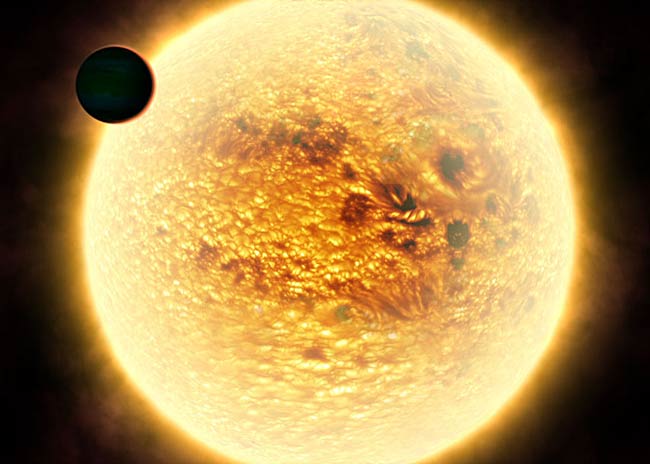Discover the hottest planet
In the hunt for extrasolar planets, a new finding often sets new records .
The planet known as WASP-12b is the hottest planet ever discovered (about 4,000 degrees Fahrenheit, or 2,200 degrees Celsius), orbiting why it is faster and closer than any known object.
The trajectory of this hot monster around the mother star only lasts for 1 day (the fastest rotating planet in the solar system, Mercury, has orbit around the sun for 88 days).
To achieve that progress, the planet rotates very close to its parent star - only about 2% of the distance from the Earth to the Sun, or 2 million miles (3.4 million km).
Queen's Don Pollacco of Northern Ireland, who participated in the SuperWASP project (planetary search project), WASp-12b discovered in this project, said: 'WASP-12b is a particularly interesting planet You, because we are in the middle of studying the extraterrestrial planets, and new examples are constantly being discovered. This is the hottest planet and has the shortest rotation known, but I think there are still hotter planets and shorter rotation. '
WASP-12b is a gas planet, weighing 1.5 times and nearly twice the size of Jupiter.
The planet, orbiting a star 870 light-years from Earth , is remarkable because it creates limits on how far the planet can get close to its star without being destroyed.
Pollacco said on SPACE.com: 'As the planet approaches the star, the radiation field becomes stronger, and at a certain extent why you will make your planet completely dissolved. In the past, some people thought that it was impossible for a planet to orbit within 1 day. I think this thinking is too early, to set a limit, you need to study a large number of objects'.
The planet's temperature is equivalent to some stars. However, it is not a star because its mass is not large enough to produce a fusion reaction used to define stars.

Illustration of the super hot planet outside the solar system above the star mother.(Photo: ESA / NASA / Frederic Pont, Geneva University Astronomer)
WASP-12b is one of the 50 extraterrestrial planets discovered by the motion method of the object, meaning that they are found by decreasing the fraction of the star's parent when the planet passes through the front of the star and block part of its light.
Pollacco said: 'This is a very difficult method, because the size of the light is reduced as the planet passes through the star, which is very small. These objects are difficult to detect, but they are of great importance because of the information they bring. '
The object's motion method allows astronomers to detect the presence of a planet while estimating its size, mass and density.By measuring the distance from the planet to the star, researchers can deduce its temperature, because the closer the object is to its mother, the higher its temperature.
All the information scientists have gathered about WASP-12b shows that this fireball is a strange case. But such findings raise a question, are such planets more popular than planets like Earth?
Pollacco said: 'Is our solar system or other solar system weird? No one has the answer. I think the faction has a series of special situations put together to create specific conditions. '
The SuperWASP project of the United Kingdom uses telescopes in Spain's Canary Islands and South Africa to search for distant planets that pass through the front of the star mother.
The discovery of WASP-12b was first published in April 2008, however the title of the hottest extraterrestrial planet and the fastest rotation was Leslie Hebb of St. John's University. Andrews, Scotland identified October 11 at the annual meeting of the Planetary Science Department of the American Astronomical Society.
- The hottest and fastest planet
- Find the hottest planet ever
- The 9 hottest places on the planet are still inhabited
- Ten strange planets of the universe
- The hottest places on the planet
- Planet is more than 4,000 degrees Celsius in the universe
- 12 hottest things in the universe
- July 2015 is the hottest month in 200 years
- Interesting things about the solar system
- Reveal the list of the 7 most massive
- The mystery of Venus
- Find a planet as hot as the sun
 Van Allen's belt and evidence that the Apollo 11 mission to the Moon was myth
Van Allen's belt and evidence that the Apollo 11 mission to the Moon was myth The levels of civilization in the universe (Kardashev scale)
The levels of civilization in the universe (Kardashev scale) Today Mars, the sun and the Earth are aligned
Today Mars, the sun and the Earth are aligned The Amazon owner announced a secret plan to build a space base for thousands of people
The Amazon owner announced a secret plan to build a space base for thousands of people NASA's 'Ninth Planet' Shows Signs of Being Friendly to Life
NASA's 'Ninth Planet' Shows Signs of Being Friendly to Life  Which planet is the oldest and youngest in the Solar System?
Which planet is the oldest and youngest in the Solar System?  Breakthrough discovery of planet with more water than Earth
Breakthrough discovery of planet with more water than Earth  How would humans die when visiting other planets?
How would humans die when visiting other planets?  Habitable planet appeared next to Earth, but met with disaster
Habitable planet appeared next to Earth, but met with disaster  Chinese spacecraft discovers mysterious cubes on other planets
Chinese spacecraft discovers mysterious cubes on other planets 